Hibiscus Bonsai Tree Care
Ultimate Genus Guide
Hibiscus is one of the most beguiling genera of flowering plants that the natural world boasts with during the flowering season. As such, this is one genus of plants that has remained as popular as it was in the old world. The uses for the plant haven’t really changed all that much either since mainstream western culture discovered it. In the old world, we used the petals and leaves of this stunning plant to make tinctures and tonics. Now, we use its foliage as part of trendy, holistic, alternative organic solutions to mainstream medication and big-pharma.
Even though our understanding of the medical properties of this incredible bloom hasn’t changed much in the centuries that we’ve been aware of its existence, our deeper understanding of where hibiscus fits into the grander scheme of the natural world has. To that end, I’d like to officially welcome you to the most comprehensive, most all-encompassing, and most in-depth article on the subject of hibiscus – outside of the realm of academic research papers that is. This may not be a thesis, but it does serve as my thesis for why this plant is so incredible, how to take care of it, and how to identify it. This is the ultimate genus guide for Hibiscus.
This article will kick off with a quick care sheet, as you’ve come to expect from us at the Bonsai Alchemist. Here, we’ll rattle off the basic concepts that the broader article will cover. This also serves as a concise way for you to judge whether you’re giving your hibiscus the attention it requires.
From there, we’ll move into every FAQ you could possibly have concerning the light and location requirements that this plant has, how much water it needs, how to negotiate fertilizing this genus of flowering plants, and what kind of critter activity you can expect. Everything you need to and has ever wanted to know about hibiscus will be in covered in this section. In addition to answering your questions, this section will also contain various links to other hibiscus articles written by yours truly. This article is literally your roadmap to my knowledge of the hibiscus genus, and it is my absolute pleasure to be able to furnish your curious and agile mind with such a guide.
Next, we’ll hop into a quick overview of the species of hibiscus we believe everyone should know of. This will range from the obscure and severely endangered, such as hibiscus fragilis, to the species everyone associates as encompassing the entire genus, hibiscus rosa-Sinensis.
We’ll then end the guide off with a conclusion of everything discussed within. Get yourself a warm cup of tea, hibiscus if you have it, or a chilled glass of your favorite summertime tonic, and settle into the ultimate genus guide for hibiscus.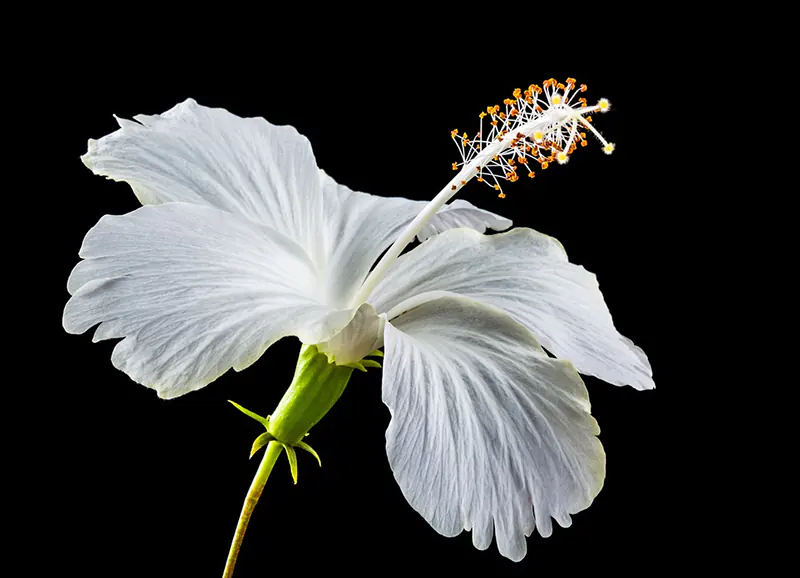
Here's what you'll find in our Coral bark
Japanese maple bonsai species guide:
Quick Sheet for Hibiscus Tree Care
Recommended soil | Loose, fertile soils rich in loam. Tropical hibiscus doesn’t do well in clay-rich or waterlogged soils. However, species like the Swamp Rose Mallow require wet soils. |
Watering | Water tropical species of hibiscus liberally during active growing seasons. Allow soil to dry properly between waterings. Dwarf species don’t require as much water. Hardy hibiscus also requires less water to thrive. |
Potting season | Late spring to early summer. |
Shaping and pruning season | Early spring. |
Light | Full sun, at least 8 hours of light a day. Some species will do well in light shade, but all species require sun to bloom profusely. |
Humidity | Most species of hibiscus enjoy moderate to high levels of humidity. |
Fertilizing | NPK with higher concentrations of nitrogen and potassium and lower concentrations of phosphorus. |
Propagation methods | Root, stem, and leaf cuttings, and water propagation |
Pests and diseases | Aphids, ants, mealybugs, caterpillars, and grasshoppers. |
Growth patterns | Annual and perennial, depending on the species |
Recommended styles | Chokkan, Kengai, Literati, and Shakan |
Native area | China, Southeast Asia, North and South America, Africa, Europe, the Polynesian Islands. |
Hibiscus Scientific Classification
- Kingdom: Plantae
- Clade: Tracheophytes
- Clade: Angiosperms
- Clade: Eudicots
- Clade: Rosids
- Order: Malvales
- Family: Malvaceae
- Subfamily: Malvoideae
- Tribe: Hibisceae
- Genus: Hibiscus
- Species: 679 Species
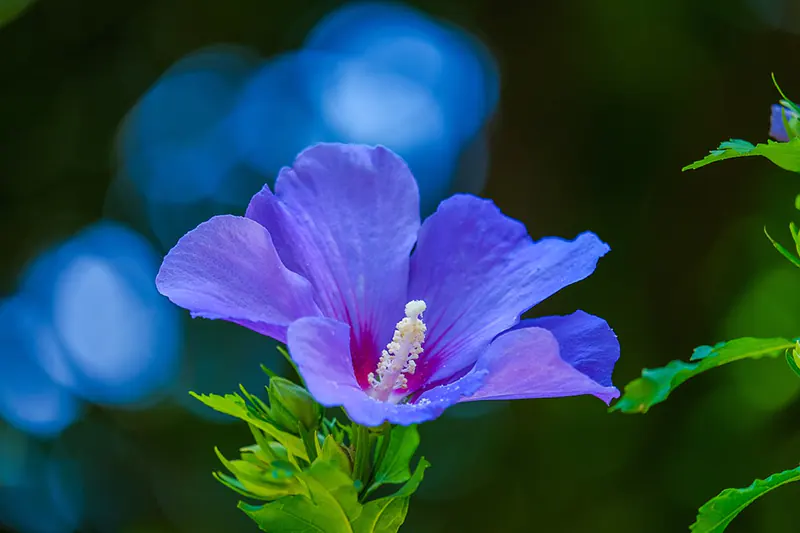
How to care for a Hibiscus tree
Light and Placement
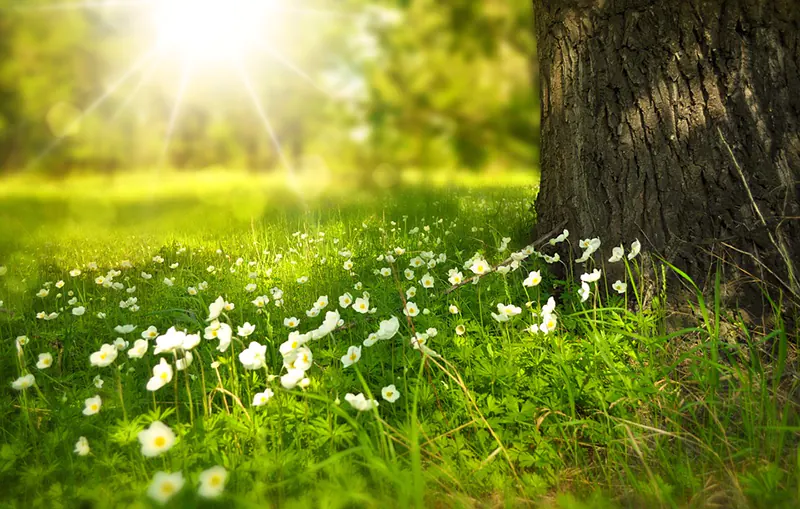
Can hibiscus grow in the shade?
Hibiscus will not thrive in conditions of constant shade. As a rule, Hibiscus requires at least eight hours of direct sunlight in order to thrive and develop its signature brilliant blooms. However, if planted in a subtropical region, Hibiscus will grow well in a position where it receives shade for up to half a day. Where possible, plant Hibiscus to the north of your house.
How many hours of sun does hibiscus need?
Hibiscus needs at least eight hours of sun every day in order to thrive. If Hibiscus doesn’t receive the exposure to direct sunlight that it requires, it will not bloom as profusely and therefore won’t put on the extravagant show it is known for. The basic survival functions of the plant may also suffer in non-optimal light conditions.
Where should I plant my hibiscus outside?
The best spot to plant your Hibiscus outside is in a position that gets full or partial sun. Here, your plant should receive the eight hours of sunlight it needs to thrive. Also, take care to plant your hibiscus somewhere it won’t be subjected to strong winds. Hibiscus tend to grow tall, and strong winds can break their stems.
Will hibiscus grow indoors?
Yes, Hibiscus will grow sufficiently well indoors. Take care to place your Hibiscus plant in a spot where it can still take full advantage of the sun. The perfect place indoors for Hibiscus is, therefore, a sunny window sill or a room that receives a good deal of sun every day. Hibiscus will still need at least eight hours of sunlight every day to thrive.
Watering

How much water should you give a hibiscus tree?
The best course of action is to water your hibiscus slowly and stop when the soil around your plant is soaked. If your plant is in a pot, watering slowly will also make it easier to see when your plant has had enough. At this point, the water will run out of the bottom of the pot through the drainage holes. In the garden, ensure that the soil is soaked at least six inches deep. This will mean that your plant’s roots have been soaked through.
Can hibiscus get too much water?
Yes. Hibiscus is very easy to overwater. Once you give your hibiscus too much water, you put your plant at risk of root rot and an early demise. To avoid this, you should allow your hibiscus plant’s soil to dry properly between waterings and not water it too often.
How do I know if my hibiscus is overwatered?
It’s very easy to tell whether your hibiscus has been overwatered. The first thing you’ll notice is that the plant might be wilting but not drying out. You’ll also see that your plant’s leaves are yellowing and swollen leaves. The last thing you should look out for is a root system that feels soft and has the scent of decay.
Should I mist my hibiscus?
Yes, misting your hibiscus is the best way to ensure that your plant receives as much moisture as it needs, but not more than it can handle. Misting the soil and roots also means that you have more control over how much water you give your hibiscus, and you can mist it with less water more often for better results.

Feeding, Potting, and Soil
How often do hibiscus need fertilizer?
The frequency with which you should fertilize your hibiscus plants depends on the time of year. You’ll want to fertilize around once every two weeks during the warmer summer and spring months. You won’t need to fertilize your plant at all during the winter, and during autumn, when the plant is likely entering dormancy, you can fertilize less frequently.
Can I use Miracle Grow on hibiscus?
Yes, you are more than welcome to use Miracle-Gro on your hibiscus plants. This dedicated plant food was specifically developed to help blooming plants perform at their best. This is also an incredibly versatile product. You can either mix Miracle-Gro into the soil, or you can simply mix it in a watering can and then apply it to your plants.
Can you fertilize hibiscus with coffee grounds?
Yes, coffee grounds are an appropriate means by which to fertilize your hibiscus plants. This is because coffee grounds are an acidic substance, and hibiscus loves acidity. You can sprinkle coffee grounds directly into your hibiscus soil. You could also mix the coffee grounds with a little water so that it may be more easily absorbed into the roots.
Is Epsom salt good for hibiscus?
Yes, Epsom salts work very well as hibiscus fertilizer. The way to use Epsom salts as a fertilizer for hibiscus plants is to toss a generous amount of the mineral around the plant so that it may be absorbed. If your hibiscus is potted, you should use one tablespoon for every gallon of soil contained within the pot.
Is vinegar good for hibiscus plants?
Yes, provided the soil within which your hibiscus is planted has a deficiency in acidity. Vinegar is a wonderful way in which to temporarily increase the acidity of your soil. This is especially true for the soil directly around your plant’s roots. The best way to use vinegar on hibiscus is to dilute one cup into one gallon of water. You can then pour the entire solution onto your hibiscus roots.
When should I repot my hibiscus?
The easiest answer here is when your hibiscus has outgrown its pot. Even though hibiscus is tolerant to growing in cramped spaces, it will eventually outgrow its pot and start to become rootbound. Once a plant is rootbound, it struggles to absorb nutrients and the roots often taken the place of all the soil or other growing medium.
Do hibiscus plants like to be root bound?
Somewhat, yes. Experts in the field have found that hibiscus rather enjoys certain levels of being rootbound. Furthermore, hibiscus plants that are slightly rootbound have been found to bloom more profusely than those that are not. As soon as being rootbound starts affecting your plant adversely, however, it’s time to repot.
Why is my hibiscus drooping after repotting?
If you see that your hibiscus plant is wilting after you repot it, your plant may be experiencing a lack of water. This usually means that you’ve repotted a plant into a dry pot or that your plant’s roots were dry before you repotted them. The best way to mitigate this is to water your plant thoroughly before repotting.
What is the best potting soil for hibiscus?
Potting mixes statistically yield better results than standard garden soil. The best mixes to use when planting hibiscus are those that contain two parts peat moss, two parts potting soil, and one part perlite or vermiculite. If you’re in a pinch, fertilized garden soil should do quite well as a growing medium too.
Do hibiscus like acidic or alkaline soil?
Hibiscus prefers to be planted in slightly acidic soil. The optimal soil for hibiscus is that which carries a pH of between 6.5 and 6.8. It’s always a good idea to test your soil’s pH before you plant your hibiscus. Should you find then that your soil is too acidic, you can use agricultural lime to netralize it slightly. If your soil isn’t acidic enough, you can use peat in the top soil of your pot or garden bed.
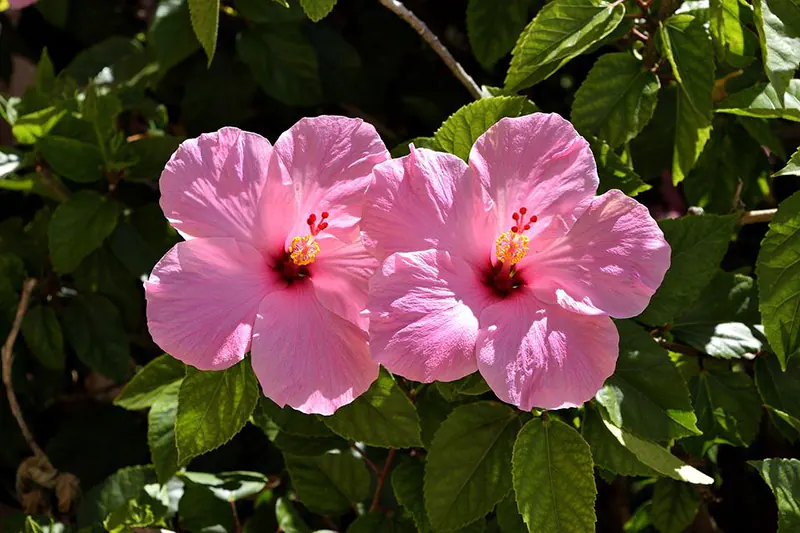
Foliage
How do I identify hibiscus leaves
Hibiscus leaves are incredibly simple compared to other flowering species. When you’re trying to identify a hibiscus leaf, you’re more often than not looking for a leaf with an oval shape. These are usually around 3-4 inches long and sometimes serrated around the edges. In terms of color, you’re likely to encounter darker hues of green.
What is the use of hibiscus leaf?
Hibiscus leaves have long been incredibly useful in treating certain ailments more naturally. In particular, the astringent properties of these leaves can be used to remedy dry coughs and low blood pressure. Topcially, these can also be used to treat certain skin afflictions. Even though more research is needed to determine the full scope of what these leaves are helpful against, they are believed to be effective against cancer and gallbladder attacks.
Are all hibiscus leaves the same?
No. Hibiscus is an incredibly diverse genus of flower plants. As diverse as the calyxes of the plants are, sometimes their leaves are even more so. Some species of hibiscus feature the classic ovate leaves that are dark green in color, whereas other species have three-pointed leaves in lighter colors. Some species of hibiscus even have dark crimson and purple foliage.
How Hibiscus leaves help in hair growth?
Hibiscus is incredibly good for hair growth due to minerals that the plant contains. These particular plants are rich in amino acids, these are the prime building blocks of keratin, which in turn boosts the formation of hair follicles. Keratin is an invaluable protein that also stimulates healthy hair growth, as well as strengthens, nourishes, and binds hair roots.
Are hibiscus leaves edible?
Yes, hibiscus leaves are edible. However, I’d exercise caution eating any leaf without first knowing that it is indeed edible. If you’re looking for hibiscus leaves to add into your next salad, I’d suggest sticking to hibiscus sabdariffa as these leaves are beneficial to your health, safe to eat, and incredibly delicious. Hibiscus sabdariffa is rather tart, and most liken it to a lemony salad leaf and equally tart fleshy fruit.
Is Hibiscus poisonous?
No. No part of the hibiscus plant is poisonous to humans. Some species of hibiscus carty significant levels of toxicity toward animals like dogs and cats, but hibiscus is non-toxic to humans. Some hibiscus plants taste better than others though. Hibiscus sabdariffa, for instance, is a tart flower that tastes similar to a sour fleshy fruit. There are many health benefits of hibiscus, too.
Do hibiscus plants lose their leaves?
Yes, hibiscus plants do lose their leaves from time to time. This can happen for many reasons, such as a change in temperature or moisture levels. Some species of hibiscus instinctively lose their leaves at the onset of winter. This is to prepare the plant for its dormancy while the temperatures are far too cold for any significant growth.
Why did my hibiscus leaves fall off?
There are numerous reasons your hibiscus can lose its leaves. To conclusively pinpoint why it has happened in your specific case, you need first check the season. If it’s winter, it’s natural for your hibiscus to begin thinning out. During an active growing season like spring or summer, your culprit is probably either too much or too little water, both of which have an effect on the structure of your plant.
What are hibiscus flowers good for?
Just like the plant’s leaves, hibiscus flowers have long been used for medicinal and decorative purposes. People have used the flowers of this pretty plant to make everything from extracts to teas, and even herbal health supplements. The flowers of the deep red hibiscus rosa-Sinensis can even be used to make hair dye. Hibiscus hair dye enhances the natural color of your hair with a crimson tint and makes it look more lustrous without drying it out.
How long do hibiscus flowers last?
Naturally, the flowers of the hibiscus plant only last a day. Some, new species known as hybrids have been specifically engineered to keep their blooms for longer. However, even these longer-blooming hibiscus flowers only keep their brilliance for around three days. It is pertinent to note, though that this means your plant should have flowers for the entire flowering season, just not the exact same buds. This is far preferable to other plants that flower for only two weeks in a year and then disappear in totality until the next year’s flowering season.
Can all hibiscus flowers be used for tea?
No, regrettably, not all hibiscus flowers are suitable to be used in tea. This is due, in most cases, to the flavor profile of the plant itself. Variants like hibiscus sabdariffa and acetosella are the most common choices for tea brewing because of how fragrant and flavorful the flowers and foliage of these variants are. Other colors and species of hibiscus have other uses where their flowers are concerned. Such as hibiscus Rosa-Sinensis being used as shoe polish and crimson hair tints.
Maintenance and Cultivation
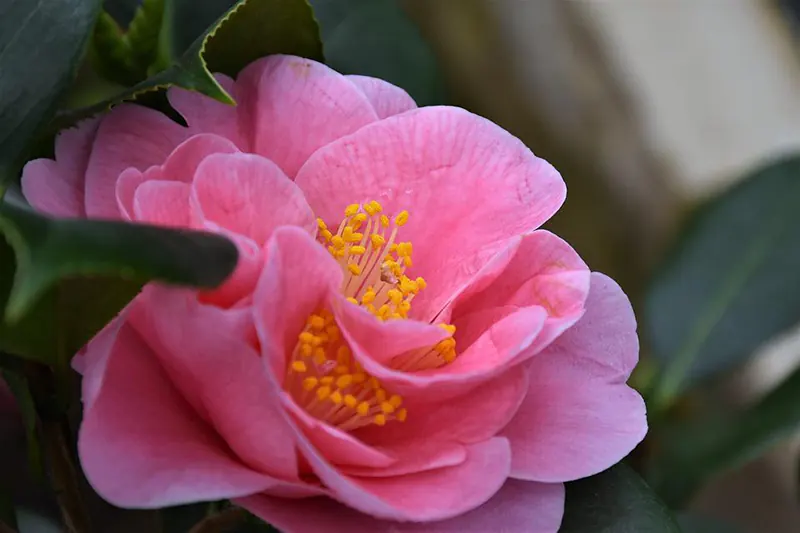
When should I prune my hardy hibiscus?
The majority of your hibiscus pruning hijinx should be localized to the spring months. This is the active growing phase of the plant. You should never prune in winter as pruning is meant to encourage further growth, and hibiscus doesn’t typically grow in the winter. You can also do a little bit of light pruning during summer or early in the fall months.
Can you cut back hibiscus hard?
Yes, you can cut hibiscus back effectively. The purpose of cutting your hibiscus plant back is to promote more brilliant flowering. Some species and variants of hibiscus can also get a little too tall and untidy, in which case you’d want to cut the plant back considerably to shape it as desired. The best practive when cutting hibiscus back is to cut a third of the way back. This leaves your plant with two to three nodes from which new growth will emerge. Always cut just above a node, and a leave about a quarter-inch of space between the cut and the node.
Can you shape hardy hibiscus?
Unfortunately, the large format flowers and foliage that hibiscus is known for do not make the plant suitable for formal shaping. These will get in the way of most structured shapes you try to achieve with your hibiscus. However, you can give your plant a rounded look and promote fuller, more saturated foliage and flower production by lightly pruning and shaping the plant as it grows in the spring.
How do you train a hibiscus plant?
Training hibiscus is relatively easy to do. All you need to do is choose the thickest, strongest stem your hibiscus shrub has, and tie a stake to it to hold it upright. Once the plant is stable you can start slowly removing other stems so that you are left with only a few stems to train into a trunk. Don’t try to rip the unwanted stems from the roots. Instead, use a sharp implement to cut the unwanted stems right to the soil line.
How do I make my hibiscus bushy?
The way to make your hibiscus more bushy and less leggy is to remove all of the wayward stringy limbs during the growing season’s first pruning. You can even cut hibiscus back as much as two thirds of the way to make it easier to shape the plant as desired. From there, simply give the plant a light pruning when it starts getting a little leggy again. Eventually the plant will conform and remain bushy with the right attention.
Wintering
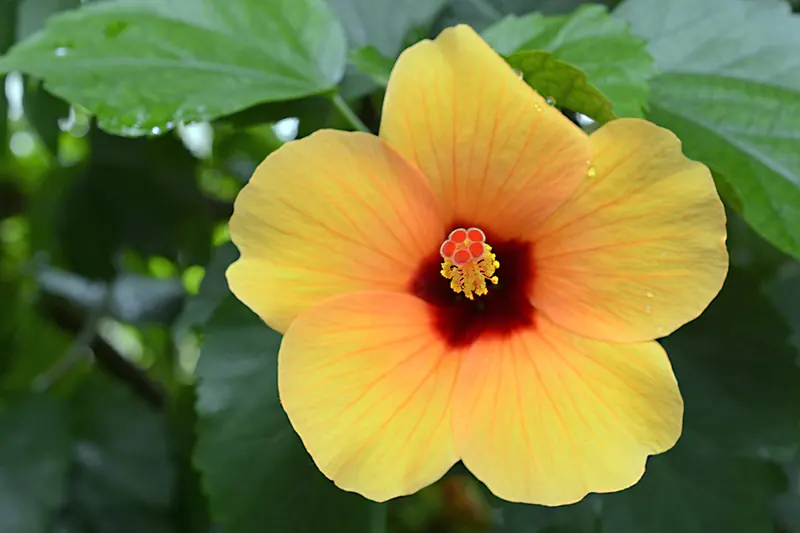
Can you keep a hibiscus inside over the winter?
Yes, in fact, this is the best practice if you live in a place that experiences cold winters. Hibiscus doesn’t like being in temperatures lower than 50 degrees Fahrenheit for long periods of time. If you live in a colder climate, you’ll have to bring your hibiscus indoors during the winter to save it and ensure that it grows well again in the spring.
Can you leave a hibiscus plant outside in the winter?
Yes, depending on where you live. If you live in a tropical, sub-tropical or equatorial region, it’s likely that your region doesn’t experience extreme winters. If your winters are relatively warm compared to places further from the equator, your hibiscus should bne perfectly fine outdoors during winter, with the right coverings and precautionary measures if needed. If you experience cold winters, you’ll need to bring your hibiscus inside for the winter.
Should you cut back a hibiscus for the winter?
Yes, you should definitely cut back your hibiscus plant in preparation for the winter. The best timeto cut back your plant is during the warmer spring months. However, you can also cut your plant back in summer and during the first few weeks of fall. You should, however, under no circumstances cut your hibiscus plant back in the winter.
How do I revive my hibiscus plant after winter?
Reviving a dying hibiscus plant is easier than you may think. First, you’ll want to change the plant’s moisture levels to support revival. Your plant’s soil should be moist but not saturated. You should increase the plant’s humidity by misting its leaves. Another thing you should do is make sure that your hibiscus has at least 5 hours of sunlight. Once you’ve got the conditions perfect, you should start seeing fresh growth emerge when the spring comes around again.
What is the lowest temperature a hibiscus can tolerate?
Hibiscus’ preferred temperature range lies between 60-80 degrees Fahrenheit. Should the temperature fall below 50 degrees Fahrenheit, your plant will begin to suffer. The scope of this suffering may take different forms, but the most common effect you’ll see is that your plant’s flowers will decrease in size, and they may be deformed. Extended exposure to cold temperatures will result in your plant freezing to death.
Will my hibiscus come back after a freeze?
Yes, depending on the type of hibiscus. Tropical hibiscus cannot survive in cold temperatures. Hardy hibiscus, on the other hand, is more than capable of surviving the cold. In the event that your hardy hibiscus experiences temperatures below 50 degrees Fahrenheit, it might die back a little. All you need to do then is prune away the dead stems and leaves. This will then make way for the new growth, which will start in spring.
Propagation
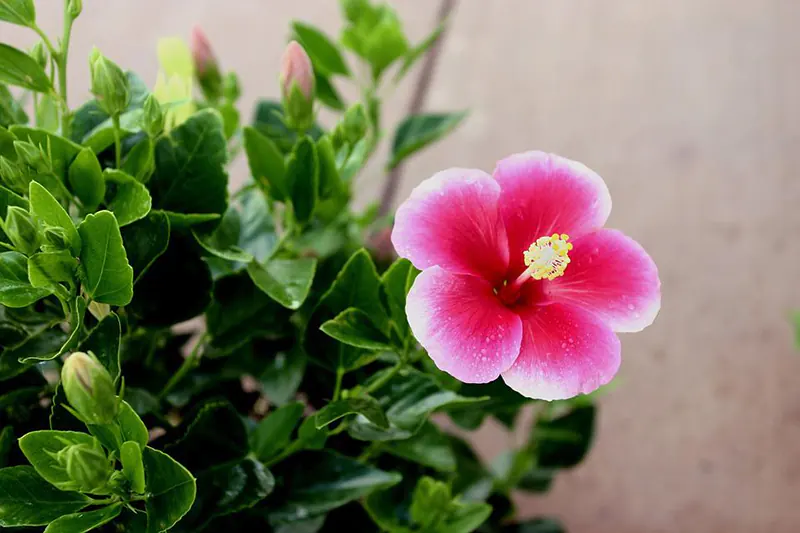
Can you root hibiscus cuttings in water?
Yes, you can. Even though hardy hibiscus is easier to propagate than its tropical counterpart, both variants are keen growers. In both cases, all you need to do is clean up the cuttings, which should be softwood or semi-softwood cuttings of between 4 and 6 inches. Then, you need to cut the bottom of the cuttings at a 45-degree angle and dip them into a rooting hormone before placing them into a receptacle of water.
When can you take cuttings from hibiscus?
You can technically take cuttings from your hibiscus plant any time of the year. However, there are certain times of the year that are better for harvesting cuttings than others. Cuttings are best harvested at the end of the winter o the onset of spring. You can also harvest cuttings during summer, but the first signs of spring are far better for the health of the resultant new plant.
How do you grow hibiscus from a stem?
Growing hibiscus from a stem is very similar to growing hibiscus from a cutting. After all, stems are a good place from which to take a cutting. All you need to do is prepare your stem as you would a cutting. Then, the best practice is to place your stem into a pot of suitable growing media, and place a clear plastic bag over the pot securely. Ensure that the plastic bag doesn’t touch the plant. You’ll also want to water the stem well before closing the system up with a bag. The little makeshift greenhouse should keep the soil moist and the stem thriving until it’s big enough to plant into a bigger pot.
How long does it take for hibiscus cuttings to root?
In most circumstances, if you’ve planted your cuttings correctly, you should start to see results after about 8 weeks. Once you’ve reached the eight week mark, you should be able to replant your hibiscus into a bigger pot so that it can grow more vigorously. Bear in mind though that hardy hibiscus is far easier to root than the tropical variety, so use these for propagation for the best results.
How do you get seeds from a hibiscus plant?
You’ll need to wait for the flowers to drop from the plant for this. Once you see that your hibiscus plant is losing its flowers, check your plant for seed pods. These will be green at first, but will change to brown and crunchy with time. Once the seed pods are brown and brittle, it’s time to harvest your hibiscus seeds. Keep an eye on the seed pods though, these can transition from green to ripe for harvest in as little as 24 hours.
Pests and Diseases

What can I spray on my hibiscus for bugs?
In truth, any spray with a robust enough stream of liquid will do wonders when you’re trying to rid your hibiscus of bugs. If you require something more than just a strong stream of water though, try to find a good insecticidal soap or neem oil-based organic insecticide. If the product is not expressly meant for hibiscus or flowering plants, don’t use it on your hibiscus.
How do I keep bugs from eating my hibiscus?
The best way to keep bugs off of your hibiscus is to use a neem oil solution. These solutions are created from the oil of the neem tree, meaning that they are natural solutions that won’t harm your plants. Neem oil is particularly voracious in the management of insects like thrips, mealybugs, aphids, and whiteflies – all of which love to snack on a vibrant and thriving hibiscus shrub.
How do I get rid of thrips on my hibiscus?
There are a few ways to get control of thrips that have taken a liking to your hibiscus. However, the best product to use to this end is called Spinosad. This is a chemical that you’ll need to spray over the top of your hibiscus plants. You’ll want to cover the buds and leaves of your plant well with this spray. For best results, use this chemical for three treatments spaced 5-7 days apart.
What causes holes in hibiscus leaves?
The world is full of creatures that want to leave holes in the leaves of your hibiscus plants. Some of the most common culprits are Japanese beetles, caterpillars, aphids, grasshoppers, and earwigs. Most of these destroy the structural integrity of your hibiscus and don’t always stop at leaving small unsightly holes in your plant’s leaves. If left unattended, these holes may result in your plant’s death.
How do you treat fungus on hibiscus?
There are numerous ways to get rid of fungus on your hibiscus. However, two of the best products to use are neem oil and baking soda. Neem oil is a natural product of the neem tree and thus is perfectly safe to use on your plants. You can also make up an organic spray with baking soda and a few drops of vegetable oil. This should be mixed with one liter of water for the perfect spray consistency.
What is the white stuff on my hibiscus?
Many people assume that fuzzy white matter on their hibiscus plants is proof of a fungal infection. However, these fuzzy white things are actually little creatures. These are called pink hibiscus mealybugs, and they are completely covered with a white fuzzy or powdery material. These mealybugs gather around the buds and new growth of your hibiscus plants and feed off of your hibiscus’ sap.
Why does my hibiscus have mold?
One of the primary reasons that your hibiscus could be infected with a disease like mold is that your plants are far too close together. Even though dense bushes of hibiscus are stunning to behold, you have to think about the plant’s health. Your plants need a good amount of air circulation between them. Hibiscus plants also thrive on sunlight and will, therefore, also start to mold if planted in too much shade.
General Guide

How can I tell if my hibiscus is hardy or tropical?
It is relatively easy to determine whether your hibiscus is tropical or hardy. The first way to check this is to look at the color of your flowers. If the flowers of your hibiscus shrub are summery colors such as orange, yellow, salmon, and peach, you likely have a tropical variety. Another identifier of tropical hibiscus species is the presence of a double flower. These flowers will look like they have more than five petals. Another way to differentiate between hardy and tropical hibiscus varieties is to see whether your flowers are primarily one color or whether they have bands or spots of different colors. A single color is usually a sign of a hardy species.
Are hibiscus perennials or annuals?
This question brings up a lot of confusion in most garden enthusiasts. Both types of hibiscus – hardy and tropical – are perennials. However, in some instances, tropical hibiscus is grown as an annual. This means that hibiscus plants typically regrow every spring. However, some people grow hibiscus as if it only flowers for one flowering season and then dies off. However, the species that gardeners use as annuals have a longer single blooming season than those used as perennials.
How many types of hibiscus trees are there?
There are several hundred species of hibiscus in the world. This is one of the largest genera of flowering plants and boasts species native to almost every region and climate on earth. Apart from the naturally occurring species, there are even more cultivars that have been crossbred or particularly seeded and grown for specific reasons such as to thrive in an even wider array of climates.
How fast does a hibiscus bonsai grow?
The species of hibiscus that gardeners grow as annuals typical grow shorter than those regarded as perennials. The true perennial species grow taller by comparison and will reach their full height after about two to three years. This is if the conditions, soil, sunlight, and water requirements are sufficient enough to promote peak growth and flower production.
How tall do hibiscus trees grow?
The total height that a hibiscus plant will reach depends entirely on the species and how the gardener chooses to train the plant. In most cases, hibiscus grows as tall as 15 feet. However, some species, like the dwarf hibiscus, only reach a few inches in height. If cultivated as a tree, hibiscus can grow taller, provided its central trunk has been made strong and wide enough to support additional height. Hibiscus bonsais are easy to keep fairly short, but can equally easily be trained to grow taller for greater variety and visual interest.
Top Hibiscus Bonsai Species
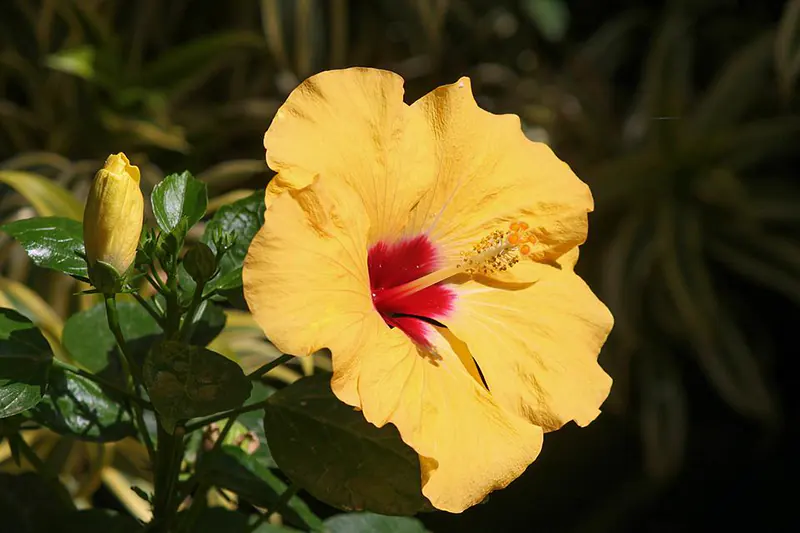
Rose of Sharon
Hibiscus Syriacus
White Chiffon and Pink Chiffon are the two most popular varieties or cultivars of this species. In the world of gardens and gardening, we refer to beauties such as the incomparable Rose of Sharon as showy flowers. This generally means that they like to put on a brilliant show every flowery season. In terms of growing particulars, these pretties will do well as tall statement pieces, low-lying shrubbery, border shrubs, and even hedges. They also make stunning bonsais.
Where is Rose of Sharon native to?
Hibiscus syriacus, also known as the Rose of Sharon, is native to Southeast Asia and China. This means that the plant is used to experiencing the relatively warm weather of the tropics and sub-tropics and doesn’t handle the cold well. If you plant hibiscus syriacus at home, be sure to keep the plant warm through the winters or bring it inside for the colder months.
Where to plant hibiscus syriacus
Hibiscus syriacus will thrive anywhere with sun and moderate temperatures. It is best to plant this beautiful shrub in full sun, although it will also do well in partial shade. As a result, you can place this stunner anywhere and expect to get the same delicate, elegant blooms every season.
Does hibiscus syriacus self-seed?
Despite its need for fertile soil rich in organic matter, this bloom is straightforward to grow and a great addition to any garden. If the conditions are right, Rose of Sharon beds won’t require much attention since the plants adapt well and self-seed aggressively. In well-drained, moist soil, Hibiscus syriacus will thrive and produce a spectacular show of blooms year after year.
What color is the Rose of Sharon
Pinks, whites, and deep reds are the most popular colors, but these shrubs also produce vivid blues and deep reds. All in all, this is the perfect shrub to add to your garden no matter what color you’re looking for. Hibiscus syriacus will complement the color palette of any garden under the sun.
Quick Care Sheet
Plant type: Perennial shrub
Native Area: Southeast Asia and China
Flower Color: White, pink, red, and blue
Bloom Time: Summer and fall
Hardiness Zone: USDA 5-8
Light: Full sun and partial shade
Water: Moderate watering
Soil: Fertile and well-draining
Rock Hibiscus
Hibiscus denudatus
Rock hibiscus is a curious little addition to the hibiscus family also known as Paleface hibiscus.. This species is native to North America and boasts none of the typical physical structures or visual cues of the classic hibiscus plant. Rock hibiscus has been described as a scraggly plant, but I think this is one of the prettiest flowering plant species I’ve ever seen. Of course, from the perspective of a bonsai and horticultural enthusiast, that list is longer than Santa’s to-do list at Christmas time.
What does rock hibiscus look like?
Hibiscus denudatus is a strange species to behold, particularly if you’re used to the more showy and exhibitionistic species of this flowering genus of plants. Even though visually, this plant looks a little parched with its dead sticks for shrubbery, it suits its native environment. Rock hibiscus isn’t always a mass of dead sticks and pretty pink flowers; its foliage is light green, and looks to be covered in fine white hairs.
Where can I find rock hibiscus
You’ll find this desert-dwelling hibiscus across the southwestern United States and northern Mexico. If you live in California, Colorado, Nevada, or Arizona, this plant should feel perfectly at home in your yard.
Does rock hibiscus lose its leaves?
Yes, rock hibiscus loses its leaves. In an effort to maintain its flowers and reproductive functions, the leaves drop off during periods of intense drought. If you want to stave off this leaf loss that rock hibiscus is known for, you should keep your plant moist, but not saturated. This way it’ll thrive for longer.
Where should I plant rock hibiscus?
As you may have guessed, this plant quite enjoys basking in the rays of the hot sun. Therefore, pick super sunny spot for these babies and they’ll be perfectly happy. If you live in a warm climate, rock hibiscus will be perfectly happy outside. If you live in a place known for cold winters, however, you may want to consider planting your rock hibiscus into pots so that they’re easier to move around. If you choose to pot this Hibiscus, a sunny windowsill or north-facing room should do quite well.
How much water does rock hibiscus need?
Even though Rock Hibiscus can thrive on very little water, you’ll want to keep your plant hydrated during hot spells. I‘d suggest watering your rock hibiscus well at least once a week during warm periods and keeping the soil moist by misting the plant during the warmest parts of cooler days. This plant is best suited to sandy soils that drain well and does not like wet feet.
Quick Care Sheet
Plant type: Perennial shrub
Native Area: California, Nevada, Mexico, Colorado, and Arizona
Flower Color: Pink and white
Bloom Time: Summer and fall
Hardiness Zone: USDA 7
Light: Full sun and partial shade
Water: Moderate watering
Soil: Fertile and well-draining
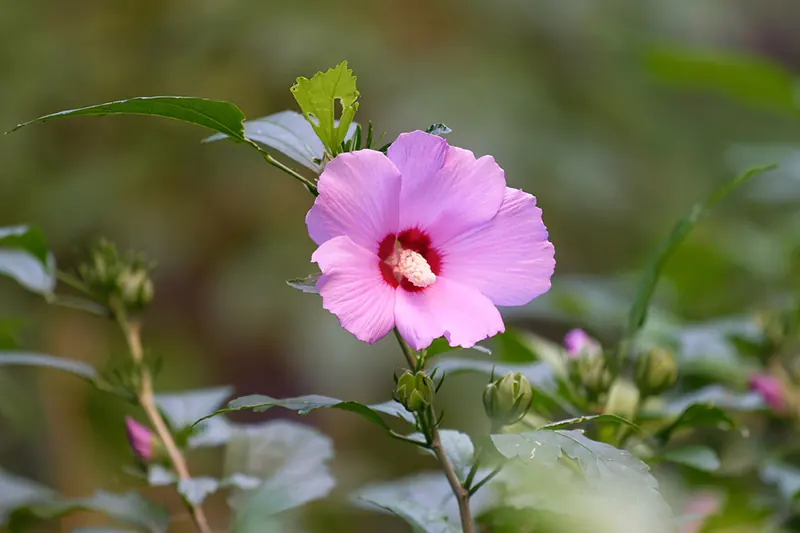
China Rose
Upon hearing the name Hibiscus, many people visualize Hibiscus rosa-Sinensis. There is a sense in which the genus has come to be defined by this one species alone. However, it is understandable that this is the case. Known as the Rose of China, the Chinese Hibiscus is among the most popular species of Hibiscus and is chosen by many gardeners when selecting foliage and flowers for their gardens.
Where does the China Rose originate from?
Even though this is called the Rose of China, you’ll find these beauties growing in the wild in many tropical and sub-tropical regions, such as the Polynesian islands, the Mediterranean, and Southeast Asia. You may be familiar with this species of hibiscus adorning the loose fitting clothing and fabrics that we associate with Hawaii. This is also an important flower in the Creole tradition where it known as the Shoeblack plant.
Where should I plant my China Rose?
The Rose of China does best in full-sun conditions, so be sure to plant this bloom on the northern side of your home if you can. Here, it can bask in the rising and setting sun, as well as when the sun is overhead. If you choose to plant your Rose of China in a pot, be sure to choose a sunny window or a room with a generally sunny aspect. This way, your plant will thrive, even indoors.
Can a China Rose tolerate cold?
No, the Rose of China doesn’t handle cold very well. This is not a particularly hardy plant, so you’ll need to keep it well shielded from frost and generally colder climates. As a bonsai, this species will do well indoors as well as out, but if you opt for an indoor bonsai, be sure to keep your Hibiscus rosa-Sinensis in a sunny spot.
How much water does the Rose of China need?
In terms of watering, two moderate waterings a week should be perfect for most climates. If you live somewhere uncharacteristically hot, you’ll need to water your Chinese Rose more often. While this plant doesn’t like wet feet, it also doesn’t take well to bone-dry soil. If you’re worried about overwatering your China Rose, use a spray bottle to mist your plant’s soil and foliage three times a week. This will keep your plant moist and thriving, without giving it wet feet.
Quick Care Sheet
Plant type: Perennial shrub
Native Area: Polynesian Islands, the Mediterranean, Southeast Asia, and China
Flower Color: Red, blue, orange, yellow, white, pink, and purple
Bloom Time: Summer and fall
Hardiness Zone: USDA 10-12
Light: Full sun and partial shade
Water: Moderate watering
Soil: Fertile and well-draining
Flower of an Hour
Hibiscus trionum
This lovely bloom is called the Flower of an Hour, and it might take you an hour to utter all the other names it goes by. In addition to its botanical name, Hibiscus trionum, this blossom also carries the names bladder hibiscus, bladder weed, bladder ketmia, shoofly, modesty, Venice mallow, and puarangi. From the names given to this particular species of hibiscus, it should be obvious that it is an invasive plant. Although it originated in the Old World tropics, this plant grows as both a weed and a garden plant in urban Europe and the United States. The term old world refers to the tropical regions of Africa, Asia, and Europe.
How big does the Flower of an Hour get?
This is one of the dwarf species of hibiscus, growing to an average height of around 8-20 inches. Because it so small, this specific species of hibiscus is best suited to be used as ground cover. Although, you can also train this species into a beautiful bonsai by thickening its stems, and if trained up a trellis or fence, this plant could also make a pretty hedge.
How much water does the Flower of an Hour need?
Contrary to many of the dwarf species, this is a thirsty little plant. If you plant Hibiscus trionum in your garden, you’ll need to keep the soil moist – this means more frequent waterings than Hibiscus rosa-Sinensis. You’ll also need to ensure that your soil is rich in organic matter and fairly acidic. Loam works really well for this species.
Where should I plant my flower of an hour?
True to the Hibiscus genus, this species loves to bask in the warm glow of the sun. This means a north-facing location is a perfect place for this little stunner. If you choose to plant this little beauty in your garden, try not to plant it in the shade. Even though this plant is perfect to use as ground cover, it doesn’t like being overshadowed by taller flowers.
Does the Flower of an Hour self-seed?
Yes, one interesting thing about Hibiscus trionum is that they’re one of the species that can pollinate themselves. If there are pollinators around, the style of this flower will remain in the perfect position to be pollinated. However, if there are no pollinators in the vicinity, the plant will take matters into its own reproductive bits and bend its style toward its anthers. This way, pollen from the plant’s own anthers can fertilize the egg and carry on the species.
Quick Care Sheet
Plant type: Perennial shrub
Native Area: Asia, Africa, Europe and the United States
Flower Color: White and crimson with dark green foliage
Bloom Time: Summer and fall
Hardiness Zone: USDA 9-11
Light: Full sun and partial shade
Water: Moderate watering
Soil: Fertile and well-draining

Roselle
Hibiscus sabdariffa
Here’s a Hibiscus you can eat. Roselle is the perfect Hibiscus for the culinary gardener, although many species of Hibiscus can be eaten. You might have seen these gems drenched in syrup or on a cutting board alongside a jar of Roselle jam if you frequent the many recipe-based pages on Instagram and Pinterest. This species was the star of our article about the culinary uses of Hibiscus. If you’re a frequent entertainer, this is the perfect plant to have in your backyard, and it makes the perfect cool-weather tea.
What do the flowers of the Roselle look like?
Even though you’ve likely only seen the soft fleshy buds, this species of Hibiscus has a really stunning bloom. When in bloom, Roselle boasts small, white, pentamerous flowers that have a deep red eye. These are incredibly eye-catching flowers and the perfect addition to any garden if you like a little visual drama.
Where to plant hibiscus sabdariffa
In terms of care, you’re going to love how easy this plant is to grow! You’ll need to plant this species in sandy loam, but you’ve likely come to expect this when a plant has anything to do with the Hibiscus genus. Roselle loves full sun and blooms better when basking in the light, like its contemporaries.
Do I need to fertilize my roselle?
No, you won’t have to fertilize this plant if your soil has the nutrients it needs. These plants are able to adapt really well and will thrive in a wide variety of conditions. This means that you can plant this species of hibiscus in virtually any soil, as long as it has some measure of nutrient content. If your soil is completely devoid of nutrients, you may have to use additives like fertilizer to make the soil hospitable for your hibiscus sabdariffa.
Can hibiscus sabdariffa handle the cold?
No, Roselle is sensitive to frost and won’t bloom if exposed to colder temperatures too frequently. This means you’ll have to try to keep your hibiscus sabdariffa protected from the cold. If you live in a cold region, you may have to plant your Roselle in a pot so that you can move it around with ease.
Quick Care Sheet
Plant type: Perennial shrub
Native Area: Tropical and sub-tropical Africa, west Africa
Flower Color: White and crimson with muted green foliage
Bloom Time: Late summer, fall, and winter
Hardiness Zone: USDA 9-12
Light: Full sun and partial shade
Water: Moderate watering
Soil: Fertile and well-draining
Confederate Rose
Hibiscus mutabilis
Also known as the cotton rose, this is the most rose-like species within the Hibiscus genus. Like the Rose of Sharon, the Confederate Rose boasts multiple corollas fused to a singular calyx. Although the Confederate Rose looks more intricate and far more impressive. This species is also one of the more interesting among the Hibiscus blooms in that it experiences a rather drastic shift in color.
What color is the Confederate Rose?
Within the space of one to three days, the Confederate Rose typically shifts from white or light pink, to a deep magenta and darker pink, and then finally a dark red. This makes the Confederate one of the most unique species of hibiscus and an asset to any garden in need of a little visual interest.
Does the Confederate Rose make a good bonsai?
Yes, this is one of the best species for bonsai cultivation. This is because the stems of the Confederate Rose grow tall and wide enough to resemble a tree quite naturally. This means you wouldn’t have to go through the same trunk thickening procedures as you would with a smaller Hibiscus plant.
When is the best time to plant a Confederate Rose?
For the best results, you should plant your Confederate Roses at the beginning of spring. This is the traditional start of the active growing phase of many flowering species of plants, including the Confederate Rose. This plant may still grow well if you plant it in the summer, but planting in spring gives your plant the best chance at success. You should never plant a Confederate Rose in the winter or cool fall months as this doesn’t give the plant enough time to establish itself.
Does the Confederate Rose need a lot of water?
No, even though this plant is typically better suited to moist, well-draining soil, the Confederate Rose is known to be fairly hardy to drought. This means that if your Confederate Rose is planted in a pot, you could keep it satisfied and quenched by just misting its foliage and soil every couple of days, without giving it vast amounts of water.
Where should I plant my Confederate Rose?
If you want to take full advantage of the brilliant blooms this species boasts, plant your Confederate Rose in the fullest rays of the sun and water well during the active growing seasons. You can plant this shrub in the shade, but it won’t flower as profusely as in the sun. If you plant your Confederate Rose in a pot, you could also place your plant in a room with a sunny aspect or on a sunny windowsill, as long as your plant receives enough hours of sunlight in a day.
Quick Care Sheet
Plant type: Perennial shrub
Native Area: Southeast Asia
Flower Color: White, pink, magenta, and red
Bloom Time: Summer and fall
Hardiness Zone: USDA 7-11
Light: Full sun and partial shade
Water: Moderate watering
Soil: Fertile and well-draining
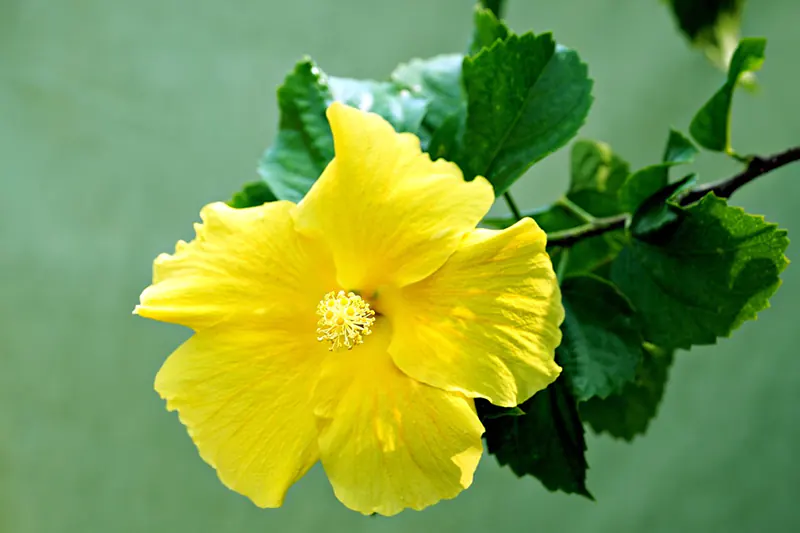
Cranberry Hibiscus
Hibiscus acetosella
This is the Cranberry Hibiscus, also known as Hibiscus acetosella, a tropical variety with the most intriguing foliage. While most Hibiscus plants feature green foliage that is sometimes covered in a white fuzz, Cranberry Hibiscus has foliage in the most beguiling shades of burgundy and copper. If you’re a fan of the Japanese maple or the cultural pastime known as momijigari, you’ll love this species. In my opinion, Hibiscus acetosella could even give the most vibrant Japanese Maples a run for their money. Unsurprisingly, this species is primarily grown for it’s ornamental leaves.
Is Cranberry Hibiscus perennial or Annual?
Unfortunately, this is a woody perennial species. This means that, unlike some species, this one won’t last for a lifetime. Woody perennials tend to only last a few years before becoming too woody and sparse to keep putting on the magnificent show they once did. Even so, these shrubs are unique enough to still be a massive asset to any garden.
Where should I plant my Cranberry hibiscus?
The best place to plant your Hibiscus acetosella is in full sun – no surprise there. This species will thrive in partially shady conditions, but you’ll experience a far more profuse blooming season if it is planted in full sun. For this reason, the best spot in your garden for Cranberry hibiscus is the north-facing side of your property. Don’t plant this species too close to a wall as it could be shaded for some time during the day.
Like most Hibiscus species, this one requires fertile, moist, well-draining soil. The best time to plant these copper-toned beauties is in the spring. This way, you’ll be treated to beautiful crimson blooms during the late summer, fall, and winter.
Quick Care Sheet
Plant type: Woody perennial shrub
Native Area: Tropical and sub-tropical Africa
Flower Color: Crimson with copper and burgundy foliage
Bloom Time: Late summer, fall, and winter
Hardiness Zone: USDA 8-9
Light: Full sun and partial shade
Water: Moderate watering
Soil: Fertile and well-draining
Swamp Rose Mallow
Hibiscus moscheutos
This is likely one of the species of hibiscus that you’ve seen in real life. Known as hardy hibiscus or swamp rose mallow, Hibiscus moscheutos is a vigorous, sturdy, rounded, shrubby perennial with hairy stems on a woody base. Typically, it grows to a height of 3-7 feet and to a width of 2-4 feet. As a native of wet areas, it can be found from Ontario and Massachusetts south to Ohio, Alabama, Indiana, and Florida. It is a species common to swamps, marshes, floodplains, river banks and moist meadows. Each of the five overlapping, white, creamy white or pink petals on the flower has a reddish-purple to dark crimson base that forms a sharply contrasting center. The flowers are dinner plate-sized – each 4-6 inches in diameter).
What is the best way to plant the Swamp Rose Mallow?
This species of hibiscus is best suited to roles like moist borders for your flower beds. You could also plant these flowers in low-lying spots or moist areas in your garden, such as around irrigation or as a feature close to a tap. These flowers also grow naturally along rivers, ponds, and streams and will therefore do well close to natural bodies of water. You could also use these blooms as a hedge or as statement pieces in large containers.
What are the water requirements of hibiscus moshceutos?
Given that this plant is native to swamps and other moist areas, you can assume that hibiscus moscheutos thrives on more water than other species. You should therefore plant this species in predominantly moist, marshy soils. You should also water your Swamp Rose Mallow deeply at least twice a week, if not more frequently in dry areas. You can, however, plant your Swamp Rose Mallow in average garden soil, provided you keep the soil moist and don’t allow it to dry out.
What are the light requirements of the Swamp Rose Mallow?
This plant is best suited to positions where it can take advantage of as much sun as possible. You can, however, plant hibiscus moscheutos in partial shade. Keep in mind, though, that thisa species of hibiscus produces the best flowers when exposed to at least eight hours of sunlight. This plant also prefers good air circulation, so don’t plant your Swamp Rose Mallow too close to a wall or fence.
Do Swamp Rose Mallows grow fast?
Yes, Swamp Rose Mallows are relatively fast-growing plants. Even though new growth is generally slow to emerge in the spring, this species grows rapidly once the first growth begins. You should, however, keep in mind that your Swamp Rose Mallows will do best with regular fertilization during the active growing phases.
Quick Care Sheet
Plant type: Herbaceous perennial shrub
Native Area: Southern and eastern North America
Flower Color: White to pink blooms with light green foliage
Bloom Time: Spring, summer, and early fall
Hardiness Zone: USDA 5-9
Light: Full sun and partial shade
Water: Regular watering
Soil: Fertile and moist
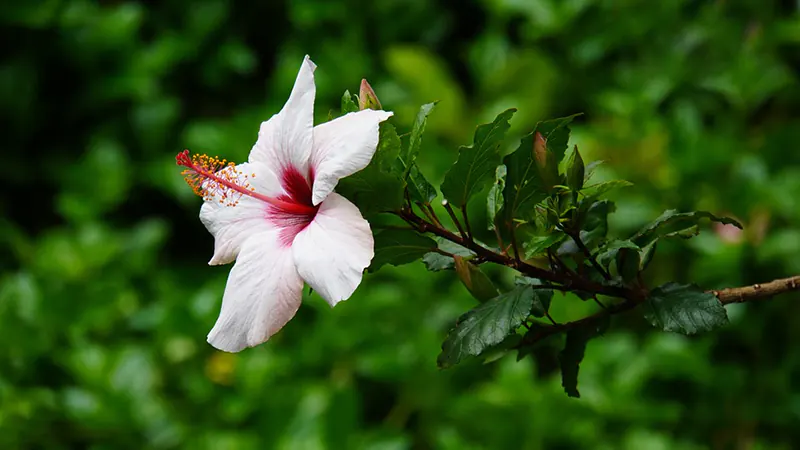
Hawaiian Hibiscus
Hibiscus Brackenridgei
Hawaiian hibiscus is technically a name used to identify seven different species of the flower genus of plants that are native to the State of Hawaii. However, when people reference Hawaiian hibiscus, they are most probably talking about Hibiscus brackenridgei, or Yellow hibiscus. Yellow hibiscus is the State of Hawaii’s State flower, and has its roots deeply embedded into the culture and peoples of Hawaii.
Is Hawaiian hibiscus endangered?
Technically, yes, hibiscus brackenridgei, otherwise known as Hawaiian hibiscus is on the endangered species list. However, the good news is that yellow hibiscus is only endangered in the specific regions of Hawaii that constitute the plant’s natural habitats. The plant has, in recent years, become incredibly popular as a garden variety shrub and many people across the islands that make up the State of Hawaii use Hawaiian hibiscus as an ornamental showpiece.
Where should I plant Hawaiian hibiscus?
As is suggested by the region of the earth that this species of hibiscus calls home, Hawaiian hibiscus prefers warm and humid weather. This also means that the best spot in your garden to plant this species of hibiscus is anywhere warm and sunny. If you live in a cold region or somewhere that experiences cold winters, you may want to plant your Hawaiian hibiscus in a pot. This way, you can move it around and chase the sun if you need to.
What does hibiscus brackenridgei look like?
Yellow hibiscus is one of the most beautiful species of native Hawaiian hibiscus. As suggested by its name, this species is yellow and comes in shades that range from plae yellow to an almost mustard hue. This plant also has really large flowers, similar to the common Chinese hibiscus or Rose of China.
Does Yellow hibiscus have a high water requirement?
No, Yellow hibiscus does not need as much water as other species may. This species will do perfectly well if you keep its soil and foliage moist by misting it a few times every week. During the hotter months of the year, you may have to water this plant more often, and it’s important that you don’t let your plant’s soil get too dry between waterings.
Quick Care Sheet
Plant type: Tropical shrub
Native Area: Hawaii
Flower Color: Yellow blooms
Bloom Time: Spring, summer, and early fall
Hardiness Zone: USDA 5-9
Light: Full sun and partial shade
Water: Moderate watering
Soil: Fertile and moist
Mandrinette hibiscus
Hibiscus fragilis
This is a species of hibiscus that you’ve likely neber heard of, unless you spend a considerable amount of time perusing the IUCN endangered species lists. Yes, this is another species of hibiscus placed on the International Union for Conservation of Nature’s infamous Red List or Red Data Book. This species of hibiscus is native to only one place on earth; the steep slopes of two of Mauritian mountains. This is a beautiful bloom, resembling the splendour and tropical majesty of the China Rose, but with slightly more textured petals.
Why is the Mandrinette so rare?
The story of why the Mandrinette hibiscus is so rare begins and ends in Mauritius. This plant is found naturally on only two of the island’s mountains; Le Morne Brabant, and Corps de Garde. This species was once a plentiful sight in Mauritius and many locals displayed the plant as an ornamental shrub. That is, until the introduction of the China Rose. Unfortunately, the Mauritian population took quickly to hibiscus rosa-Sinensis, even though it was an invasive, alien species, and the latter rapidly replaced Mandrinette as the island’s favorite flower. Another issue is that Mandrinette couldn’t multiply – the few plants that still existed naturally – as the invasive species dominated reproduction and almost erased every trace of Mandrinette’s genetic material in the resultant shrub.
Will the Mandrinette become extinct?
Hopefully not. Since the plant has been placed on the IUCN’s Red List, naturally occurring examples of the species have dwindled to only 46 mature individual plants. However, efforts are being taken to reintroduce the native species now that the invasive species no longer poses a threat to its survival. At a current estimate, there are over 200 individual Mandrinette hibiscus shrubs in nurseries across the globe. The Royal Botanic Gardens, Kew, is currently also attempting to reproduce the species’ seedlings so as to ensure the plant’s survival.
What does Mandrinette hibiscus look like?
If you’ve seen hibiscus rosa-Sinensis, you’ve seen something similar to the Mandrinette hibiscus. Although, there are several distinct differences between the two plants. For starters, rosa-Sinensis grows in various different colors, depending on the cultivar. By comparison, the Mandrinette is a primarily pink plant, although it can range from bright pinks to an almost carmine red. Another difference is that the petals of the Mandrinette hibiscus have slightly more texture, and seem to even have slight stripes of a lighter shade to the rest of the petals.
Quick Care Sheet
Plant type: Tropical evergreen shrub
Native Area: Mauritius
Flower Color: Pink blooms ranging from bright pink to carmine red
Bloom Time: Late summer, fall, and winter
Hardiness Zone: USDA 7-9
Light: Full sun and partial shade
Water: Moderate watering
Soil: Fertile and well-draining
Hibiscus Tree Bonsai Inspiration
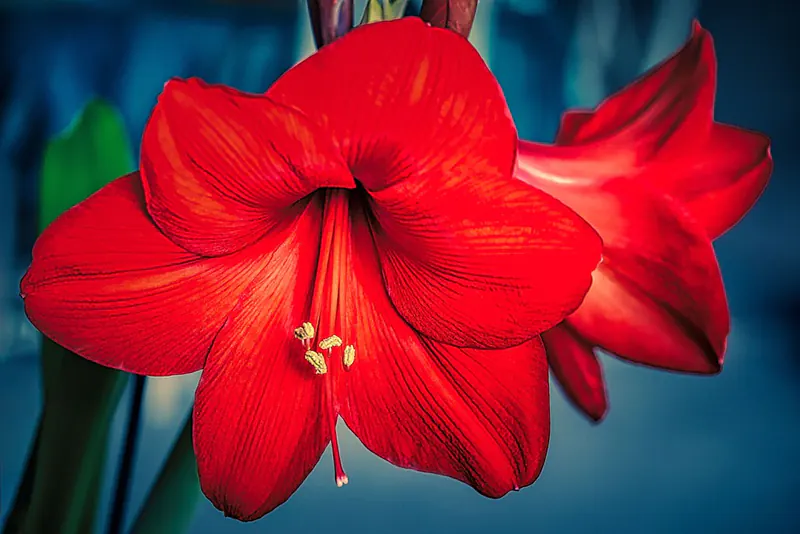
Where to find inspiration for hibiscus bonsais
The world is honestly full of places to find inspiration for the humble and quiet art of bonsai cultivation – especially as it pertains to hibiscus. Hibiscus isn’t everyone’s first choice when it comes to bonsais. Most people think of the resolute oaks and pines or the serene junipers when someone drops the word bonsai in conversation. However, one quick scroll through popular social media platforms such as Pinterest or Instagram will show you a whole new side of hibiscus.
Do it. I dare you. Head to the search bar in Pinterest and type in ‘hibiscus bonsai.’ Tell me what you find. In all likelihood, you’ve just been served scroll after scroll of the most incredible examples of hibiscus bonsais. Look at what other people have done with their hibiscus shrubs. Isn’t it marvellous? Doesn’t it inspire you? I hope it does. If you’re lucky enough to be the proud owner of a hibiscus plant or a few of them, these images that you see on Pinterest are all a testament to what your plant could become.
Yes, gardens are stunning. I love meandering through a manicured and well-loved garden as much as anyone else, but going outside into nature to experience the wonder of hibiscus isn’t the only way to bask in this plant’s glory. Bonsai it. That way, you can bring the stunning colors of hibiscus rosa-Sinesnis into your home. Who wouldn’t want a Confederate Rose perched pride of place on their mantel? Is there really any drawback that you can think of to having your very own personal hibiscus sabdariffa sitting in a sunny spot on your kitchen counter? There’s a spot in every home for a bonsai. Why not make it an hibiscus, and why not style it with inspiration from a platform like Pinterest.
There’s another aspect to social media that we sometimes overlook – the very reason that this class of internet platforms and mobile apps exist. To be social. I’m no social bunny, but even I can admit that there are such benefits to be found on platforms like Pinterest and Instagram – Especially Instagram. Here, you can not only find images of hibiscus that can serve as inspiration for what you inevitably do to your own garden or lone hibiscus plant. You can also get in touch with other people who share your passion for hibiscus and bonsai cultivation.
This is your chance to join a community of like-minded souls or create a brand-new thriving community. Get online, get connected, but more importantly, get offline and get together. Take your new friends and venture out into the world in search of hibiscus plants and the bonsais that result from care and attention. Go to fairs, conventions, and festivals and sample the finest hibiscus-themed cuisine. Hibiscus is all the rage right now., Why not sample a Red Sorrel tea or a fresh, summery salad made from the foliage of hibiscus sabdariffa, lightly seasoned with salt and pink pepper?
Social media serves as more than just an inspiration for the incredible things you can do with your hibiscus plant. Social media gives you the chance to meet like-minded people that you may otherwise never have come into contact with.
Are there videos for hibiscus bonsais?
Yes, YouTube is full of videos that detail the best practices in terms of looking after hibiscus. During my research, I came across hundreds of videos that give a lot more information than the usual short guide format articles do. Our articles are excluded from this, as we try to make each and every piece we write as informative and entertaining as possible while retaining as many facts and hibiscus truths as we can.
Youtube is particularly helpful if you’re looking for very specific information that the wider internet doesn’t prove access to aside from the small Google blurbs that search engines sometimes churn out. By this, I mean that if you’re looking for a practical guide on how to propagate hibiscus from a single leaf – yes, this is possible, as we detail in our article about hibiscus propagation – YouTube will likely have the answer for you.
Another thing that I really love about using YouTube as an informative and educational source, is that you can see what’s happening. Look, I try as far as possible to describe things in such a way that anyone, anywhere can follow along with guides and the processes detailed therein. However, I’ll be the first to admit that it’s sometimes difficult to mirror the actions taken by a gardener or guide when detailed in text. It’s far easier to follow a guide when you can see exactly what the narrator’s hands are doing.
If you haven’t yet, check out our dedicated YouTube channel where we have numerous videos detailing various processes to do with bonsais. We haven’t quite mastered alchemy yet, our resident alchemist and Editor in Chief has been hard at work creating informative content for this website, as well as creating new websites that encompass his – and our collective passions. He’s also been working on his publishing company which will hopefully soon boast many new releases and greater successes.
As such, our transmutation efforts have been slow as of late. Jokes aside, our platform, and our space on YouTube and other social media will only grow from strength to strength. In the coming months we will produce videos that encompass much, if not all, that we cover so passionately on our website, in such a way that your hands can follow along with ours. The only thing more beautiful than being able to share knowledge and thoughts with you, is being able to do so in such a way that brings you directly into the experience. We live to share our passion and dedication to bonsai and wider horticulture and spirituality with you.
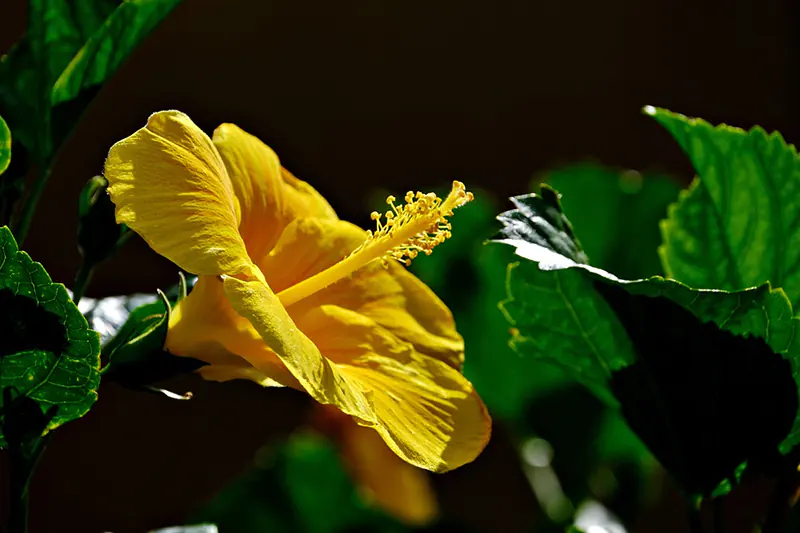
Final thoughts
Hibiscus is honestly one of my favorite plants on the face of the earth. This is one of the most unique and versatile species of flowering plants and I think they’re an asset to any garden, no matter where you live. Below, we’ll quickly summarize everything we know about hibiscus thus far so that we can end off this ultimate guide to all things hibiscus the right way.
In terms of light and location, it’s best to refer to the species of hibiscus that you have. We’ve tried to include as many diverse species in this guide as possible, but as new species are permanently being found or cultivated, this is a near impossible task. However, there are a few general rules you can follow where hibiscus’ light and location requirements are concerned. Hibiscus isn’t a winter plant. This means that planting your hibiscus in the sun where it can bask in as many hours of natural sunlight as possible is always the best idea. As we’ve discussed at length in these articles, hibiscus absolutely loves the sun.
In terms of location, this means that you want to plant your hibiscus shrub wherever it will see the most hours of sunlight. Given that the sun rises in the East and sets in the West, neither of these sides of your property is completely suitable. However, if you want your hibiscus to bask in only the first rays of the morning sun, until around 1 pm – depending on the position of your house and the shadows it casts – the eastern side of your house is perfect. If you’d prefer that your hibiscus harness the waning rays of the afternoon sun, then you’ll want to plant it on the western side of your property.
Given how shadows move throughout the day, the South is rarely a good location for sun-loving plants like hibiscus. The northern side, however, is absolutely perfect. You also don’t want to plant your hibiscus too close to a fence as this can cast a shadow that your hibiscus will not be happy with. Another thing to keep in mind is not to plant hibiscus plants too close to each other. They can end up with mold or mildew as a result of not having enough space for air to flow between them.
When it comes to watering your hibiscus, less is always more, except in the case of the Swamp Rose Mallow. On average, though, hibiscus prefers well-drained soil that doesn’t retain water too well. Hibiscus does not like to have wet feet. You should water hibiscus at least two times a week. The depth and duration of these waterings will depend on the individual species, but a reasonable baseline is to give your plant a deep watering once a week, followed by a misting or moderate watering 3-4 days later. Always water your hibiscus slowly.
This gives the soil as much chance to absorb the water it needs. Watering slowly is also a prerequisite if your hibiscus is planted in pots. This actually lets you gauge how much water your pot needs, as you’ll be able to see at which point the water starts leaving the pot through the drainage holes. When the water starts seeping out of the drainage holes, it may be time to stop watering.
As far as other care is concerned, hibiscus is a fairly easy plant to look after. Watch your plant’s leaves for signs of what it may need, and don’t let its soil dry out between waterings and you should have a plant that will thrive for a long time.







